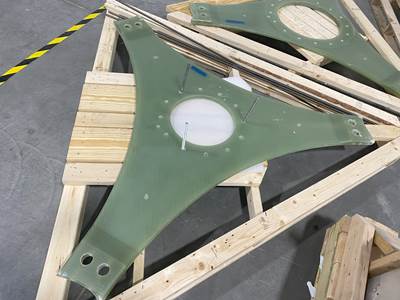VIDEO: High-rate composites production for aerospace
Westlake Epoxy’s process on display at CAMX 2024 reduces cycle time from hours to just 15 minutes.
Scott Francis, editor-in-chief of CompositesWorld, spoke with Amitabh Bansal of Westlake Epoxy at CAMX 2024. Westlake’s display included a 15-minute production cycle for an Airbus airplane gutter using vacuum-assisted resin transfer molding (RTM) technology, cutting production time from hours to minutes.
Bansal shared that in the last 5-6 years, technology used in automotive manufacturing has been adopted in the aerospace industry, with a focus on sustainability. Jump to transcript excerpt
Scott Francis (SF)
Hi there. I’m Scott Francis, editor of CompositesWorld, and I’m here at Westlake Epoxy’s booth, talking to Amitabh Bansal, segment leader for composites. We’re discussing high-rate production for aerospace. Amitabh, tell us some about some of your solutions.
Amitabh Bansal (AB)
Well, thanks for talking to us. Really, this story started with automotive about 15 years ago, where build rates, quality and efficiency were key. The automotive OEMs like BMW, Volvo, they’re using our resin systems to make parts. Over the last 5-6 years, we’ve seen a transition of that technology from automotive into aerospace.
In aerospace they want to make the planes lighter. They want to make them more efficient. There is an ESG [Environmental, Social, Governance] component to that, that as well. And we see larger and larger adoption of composites overall, right? So as an example, things that used to take hours to lay up, build, pull out of the mold now can be done in less than half an hour. And then there are technologies to automate those completely that goes toward efficiency, less wastage and high rates of production.
SF
Tell us about some of your approaches to this.
AB
It really depends on the part’s complexity — how big the part is, how thick the part, is it structural, is semi-structural, but largely we break down our approach to two things: the efficiency of making things.
Sustainability is a topic that comes up quite a lot. It’s primarily driven by product carbon footprint reduction. We not only have resins that are either bio-derived or made using renewable energy, but there is also efficiency, which means less consumption of power, less consumption of material, less wastage overall and that also goes toward the carbon footprint of the end user and the producer of the part.
What you’re looking at here is an airplane gutter for Airbus that was made by Daher using traditional prepreg technology. To lay up this part and mold, it takes hours. Using vacuum-assisted RTM, this turns into a 15-minute cycle from layup to part extraction. And it’s a production-ready part at that point. So you can do that using epoxies. You can also do that using phenolic resins. And both of these are made using proprietary technology that Westlake has come up with.
So what you have here, Scott, is a turnkey solution provided by one of our partners, our automator Coriolis. They’re based out of France, and they’ve come up with this automated fiber placement technology, which is then secured with a felting technology, to make it stiff, so that once you place the fibers, they don’t move. In this process, some of our binders have been used, which is then formed into a preform, so that, again, it’s stiff and also ensures you’re not losing any of the translation of the carbon fiber properties to the final part. This is then water jetted out into a preform. And this is what goes into your mold. It gets injected with the resin and out pops a part like this.
And the key here is that each step in this process is taking 3-4 minutes. So if you combine the whole cycle process from end to end, you’re coming up with a 15-20 minute part; using traditional hand layup or other kinds of technologies, this would have taken a couple of hours to build. So as you can see, on that part, it’s got fine angles, and using computer simulations, and you can optimize how to lay the tape or the fiber. And this can also predict what the end properties, mechanical properties of the part are going to be.
So again, you can see how all of this started with automotive OEMs. And this is what is being now adopted more and more in the aerospace industry.
Related Content
ASCEND program update: Designing next-gen, high-rate auto and aerospace composites
GKN Aerospace, McLaren Automotive and U.K.-based partners share goals and progress aiming at high-rate, Industry 4.0-enabled, sustainable materials and processes.
Read MorePEEK vs. PEKK vs. PAEK and continuous compression molding
Suppliers of thermoplastics and carbon fiber chime in regarding PEEK vs. PEKK, and now PAEK, as well as in-situ consolidation — the supply chain for thermoplastic tape composites continues to evolve.
Read MoreManufacturing the MFFD thermoplastic composite fuselage
Demonstrator’s upper, lower shells and assembly prove materials and new processes for lighter, cheaper and more sustainable high-rate future aircraft.
Read MoreCombining multifunctional thermoplastic composites, additive manufacturing for next-gen airframe structures
The DOMMINIO project combines AFP with 3D printed gyroid cores, embedded SHM sensors and smart materials for induction-driven disassembly of parts at end of life.
Read MoreRead Next
Designing an infused, two-piece composite baseball bat
With its Icon BBCOR bat, Rawlings leveraged its experience in braided fabrics and RTM to create an optimized, higher-performance two-piece design.
Read MoreRTM, dry braided fabric enable faster, cost-effective manufacture for hydrokinetic turbine components
Switching from prepreg to RTM led to significant time and cost savings for the manufacture of fiberglass struts and complex carbon fiber composite foils that power ORPC’s RivGen systems.
Read MoreVIDEO: High-rate composites production for aerospace
Westlake Epoxy’s process on display at CAMX 2024 reduces cycle time from hours to just 15 minutes.
Read More






















